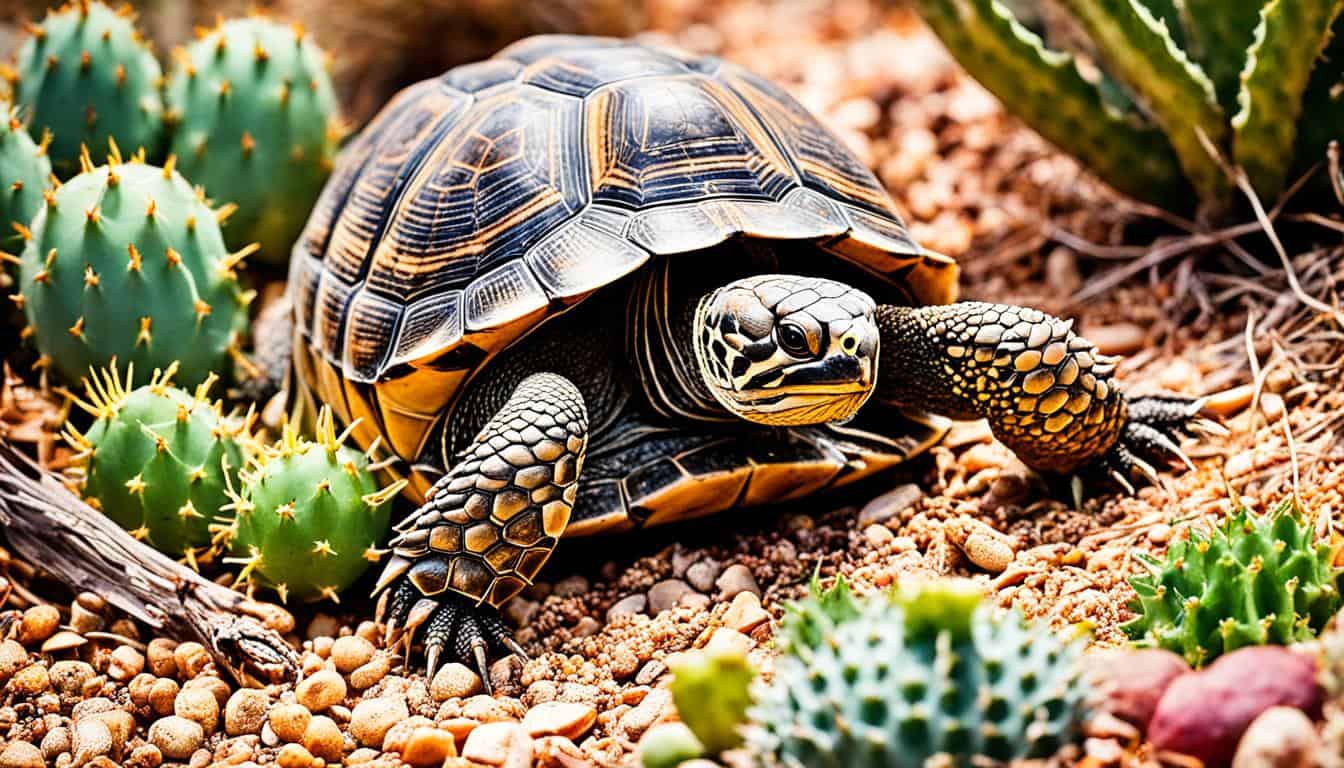Understanding the desert tortoise diet is important for their well-being. These herbivores come from the desert areas of the US and Mexico. They eat a lot of fiber, some protein, low fats, and need calcium. In the wild, they munch on grass, weeds, and dark greens.
In captivity, a desert tortoise’s diet should be mostly grass, weeds, and greens. This makes up 85% of their food. The other 15% includes hard veggies to mix things up and add more nutrients. A varied diet is important for tortoise health, helping them steer clear of diet-related problems.
Introduction to the Desert Tortoise
The desert tortoise is a remarkable reptile living in the dry lands of the southwestern U.S. and northern Mexico. It’s known for surviving tough conditions. These creatures have special ways to live in their environments.
Natural Habitat and Behavior
Desert tortoises make homes under bushes, soil, and rocks. They come out at dawn and dusk to search for food when it’s cooler. Their main menu includes plants like grasses and weeds.
Remember, desert tortoises are in danger. It’s not okay to take them from the wild or let them go after being pets. This is to protect their health and chances of staying alive.
Special Characteristics
These tortoises have unique features. They can live for up to 60 years and become adults in 5 to 10 years. You can tell males and females apart by looking at their shells and tails. For their best chance at a long life, feed pet tortoises food that’s like what they find in the wild.
What is the diet of a desert tortoise?
The desert tortoise diet is like what they eat in the wild. They mainly eat grasses, weeds, and leafy greens. This makes them herbivorous reptiles who need a high-fiber, moderate-protein diet.
For tortoise nutrition, focus on grasses and weeds. These are their main food. They eat grasses like Bermuda grass and ryegrass to stay healthy.
Leafy greens are also very important. Use dark, leafy vegetables like dandelion greens and mustard greens. But, be careful not to give too many fruits or other vegetables. This keeps their diet balanced and prevents problems from eating too much of certain foods.
Follow these diet tips for a healthy desert tortoise. This way, their food is much like what they’d find in nature.
The Role of Grasses and Weeds in Their Diet
Grasses and weeds are key in a desert tortoise’s diet. They make up most of what they eat and give them essential nutrients. Knowing what types of plants they eat and how they find them is important.
Types of Grasses and Weeds
Desert tortoises eat a variety of grasses and weeds, such as:
- Alfalfa hay
- Bermuda grass
- Mallow
- Opuntia cactus pads and flowers
- Rye grass
Fresh clover and sowthistle are especially important for them, making up 85% of their diet. They love to graze on these.
Foraging Behavior
Desert tortoises look for food mainly in the morning and evening. They are after the freshest grass and weeds then. This helps them get the fiber and nutrients they need.
Making sure they can still forage in captivity is crucial. This means giving them plants they would find in the wild. It’s part of good tortoise care.
Importance of Leafy Greens
Leafy greens are key to keeping a desert tortoise healthy. They provide important nutrients. You need to know the best leafy greens for your tortoise to care for it well.
Recommended Leafy Greens
- Collard Greens
- Endive
- Grape Leaves
- Dandelion Greens
- Mustard Greens
Health Benefits
Many types of leafy greens are great for tortoise nutrition. They give vitamins and minerals. They also keep the digestive system healthy and boost well-being.
But, some greens need to be limited. For example, dandelion greens are high in calcium. But, don’t give them in too much. Overdoing it can cause problems like metabolic bone disease or thyroid issues.
Mixing things up and finding a good balance in leafy greens helps your tortoise eat well.
Vegetables to Include in a Desert Tortoise’s Diet
For an ideal desert tortoise diet, mix up some vegetables. This ensures they get proper tortoise care. These veggies should be about 15% of their food. They add to the grasses and greens they mainly eat. It’s key to choose foods rich in nutrients.
These vegetables help provide a well-rounded desert tortoise diet. They also meet the needs of tortoise care. Each type gives your pet special vitamins and minerals. For instance, bell peppers have vitamin C. Sweet potatoes have fiber and beta-carotene.
It’s important to vary the diet to avoid missing nutrients. Veggies like green beans and peas are great for protein. By cutting them into small pieces, you make them easy to eat. Always serve them fresh for the best digestion.
Keeping your tortoise healthy means offering a mix of vegetables. This complements their main food and takes good tortoise care practices. A diet full of varied veggies keeps them strong. It’s like bringing their natural meals indoors.
Fruits: Treats and Moderation
Fruits are great for a desert tortoise but should be occasional. They add to the diet and keep it interesting. But remember, too many can cause health issues.

Fruits to Offer
For your tortoise, try apples, berries, and melons. Feed them in small amounts to add nutrients without overloading.
Frequency and Quantities
Fruits are not a daily part of a tortoise’s diet. They should be served less often and in small portions. Apricots, figs, and mangoes make good treats, keeping their diet varied and healthy.
| Fruit | Recommended Frequency | Portion Size |
|---|---|---|
| Apples | Occasional | Small slices |
| Berries | Rare | One or two |
| Melons | Occasional | Small chunks |
| Apricots | Occasional | Sliced |
| Figs | Rare | Small pieces |
| Mangoes | Occasional | Small pieces |
Stick to this plan to keep your tortoise’s diet healthy. They’ll get the right amount of fruit without overdoing it. This way, you’ll keep them happy and healthy.
The Role of Supplements
To make sure your desert tortoise is healthy, adding supplements to its food is key. These supplements act like what the tortoise would find in the wild. They help maintain health and a long life. Tortoises need extra minerals and vitamins that can be missing from their food.
Calcium and Vitamin Needs
Calcium is vital for strong bones and shell upkeep. Sprinkle calcium carbonate powder on their damp food each day. Also, give a vitamin supplement once a week. This covers any diet gaps they might have because of being in captivity.
Caring for tortoises means more than just feeding them. The right supplements are crucial too. By meeting these nutrition needs, you can avoid many health problems. Your tortoise will be happier and healthier.
| Supplement Type | Purpose | Frequency |
|---|---|---|
| Calcium Carbonate Powder | Strengthening bones and shell | Daily |
| Vitamin Supplement | General health and immunity | Weekly |
Following these supplement tips greatly enhances your tortoise’s care. It helps keep them healthy and well-balanced.
Water Requirements for Desert Tortoises
Desert tortoises need water to stay healthy, even though they are from dry places. They should have a shallow dish of water available to drink and soak. This is important in a controlled setting.
Tortoises don’t drink every day, so soaking baths are key. These baths keep moisture levels just right. They prevent dehydration, help in digestion, and keep the tortoises healthy.
To make the perfect home for a desert tortoise, mimic their wild habitat. This means adding water and keeping the air moist. Even though they save water well, access to water keeps them healthy.
| Water Source | Hydration Method | Frequency |
|---|---|---|
| Shallow Water Dish | Drinking and soaking | Always available |
| Soaking Baths | Total body hydration | Weekly |
Knowing how much water desert tortoises need lets us create the best home for them. This helps them live a long, healthy life.
Feeding Tips for Pet Desert Tortoises
Feeding a pet desert tortoise right means knowing what they need to thrive. The type of home, either indoors or outdoors, makes a big difference in their health. It’s also important to avoid some common mistakes to keep your tortoise happy and well.
Indoor vs. Outdoor Environments
Desert tortoises are happiest in outdoor homes. This gives them a lot of room and the sun’s UVB rays they need. They can also eat the plants around them, which is like their natural diet. But, if outside isn’t possible, indoor areas can be good too.
For indoor spaces, keep it 75-85°F overall, and a warm spot at 95-100°F. This keeps your tortoise lively. Use things like cypress mulch or soil and sand mix for the floor to keep your pet safe.
Avoiding Common Pitfalls
Picking the right food is key for a tortoise. Stay away from iceberg lettuce since it doesn’t help them stay healthy. Instead, choose foods that are high in fiber, like plants, weeds, and special tortoise food. This will make sure they get all the nutrients they need.
Don’t just feed your tortoise only commercial pellets. These should be just a small part of their diet. Changing the types of food you give them often is essential. It keeps their meals well-rounded and your tortoise in top shape.
Herbivorous Reptiles and Their Unique Needs
Herbivorous reptiles, like desert tortoises, need a specific diet to stay healthy. They eat a lot of fibrous, low-fat foods. This diet includes native grasses, weeds, and leafy greens.
Knowing what the desert tortoise diet should be is crucial for their care. It’s important to provide a wide variety of plants. But, be careful not to give them too much of some kinds.
Properly feeding a desert tortoise is vital. It helps them stay healthy and avoid sickness. By learning about their needs and diet, you can take excellent care of these herbivorous reptiles.
Health Issues Related to Poor Diets
It’s vital to give your desert tortoise a balanced diet. This can prevent serious health problems. For instance, if they eat too many foods with calcium oxalates, their bones may weaken. This makes them more likely to break or twist.
Kidney disease is also a big worry. It can be caused by eating too many fruits. Even though fruits are tasty, their sugar means your tortoise should only have them occasionally. Too much fruit might lead to kidney stones and other kidney problems.
Bad diets can also cause stomach issues. Following the right diet guidelines, which stress more grasses and greens, is key. It’s important to limit how many vegetables and fruits your tortoise eats. This careful diet control will keep them in good health.
FAQ
What is the diet of a desert tortoise?
The desert tortoise eats plants and is mostly found in the wild. It eats a diet full of grass, weeds, and dark greens. When kept as pets, their diet should be 85% plant-based, with the rest being some hard vegetables and a few fruits.
This mix gives them what they need, like not too much protein and not too much fat, but plenty of calcium.
What is the natural habitat and behavior of a desert tortoise?
These tortoises live in dry areas with bushes and rocks in parts of the U.S. and Mexico. They come out in the early morning and at night to eat. It’s important to make their home look like where they come from to keep them healthy, especially if they’re pets.
What are some special characteristics of desert tortoises?
Desert tortoises can have long lives, up to 60 years, and they’re ready to make baby tortoises between 5 and 10 years old. You can tell boys and girls apart because boys have a curved bottom shell and a longer tail.
It’s not good to take them from where they live in the wild. They are in danger, and they find it hard to survive outside their home.
Why are grasses and weeds vital in a desert tortoise’s diet?
Grasses and weeds are very important for a desert tortoise. They give the tortoises things they need like fiber and calcium. This kind of food is key for their health and how they look for their food.
What types of leafy greens are recommended for a desert tortoise’s diet?
Dandelion greens, mustard greens, and collard greens are top choices. Grape leaves are also good. These greens should be most of what they eat but not more than a half to keep them healthy.
Which vegetables are suitable for a desert tortoise’s diet?
Bell peppers, carrots, and peas fit well with their main diet of grasses and greens. Also, sweet potatoes and turnips are good. All these vegetables can be about 15% of what they eat.
What fruits can be included in a desert tortoise’s diet and how often should they be offered?
Sometimes, you can give them fruits like apples and berries. Melons are okay too, but only once in a while. Feeding them fruits this way keeps their diet balanced and healthy.
What supplements are necessary for a desert tortoise?
It’s important to give them extra calcium and vitamins. Daily, sprinkle calcium powder on their food. For vitamins, a small dose once a week is plenty to make sure them well.
What are the water requirements for desert tortoises?
While desert tortoises may not drink from a dish every day, they need water for soaking. Soaking is how they keep their bodies hydrated and healthy.
What feeding tips are essential for pet desert tortoises?
Give pet desert tortoises lots of sunlight if they’re outside. If they’re indoors, keep their home warm and use the right bedding. Don’t feed them lettuce; it’s not good for them.
What are the unique dietary needs of herbivorous reptiles like desert tortoises?
These tortoises need a diet full of plants and low in fat. This includes wild grasses, weeds, and greens. Knowing what they should eat helps keep them from getting sick and makes sure they’re happy in captivity.
What health issues can arise from an unbalanced diet in desert tortoises?
Eating the wrong foods can make them sick. They might get bad bones, kidney trouble, or have stomach issues. Making sure they eat the right amounts of different things is the best way to keep them well.







